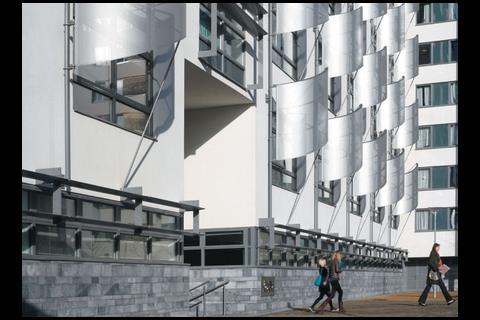It’s a tricky one: higher education institutions have to slash capital spending plans, but they need to keep upgrading their estates if they want to attract students and, consequently, funding
As school leavers and the unemployed have turned to higher education for shelter from the economic storm, so too have construction firms, attracted by a relatively steady market worth nearly £3bn. This means the recently announced cuts in government funding for universities have dealt a blow all round. A reintroduction of the cap on student numbers has left a lot of disappointed would-be undergraduates and some gaping holes in estate strategies. With the 14.9% cut in capital funding for the year 2010/11 and threats of further cuts from both major parties, many universities have started to slash spending plans, delaying developments indefinitely.
In fact, the cuts for 2010/11 in themselves are not that dramatic. Government funding accounts for less than a third of universities’ capital spending, and in England, they will be weighted towards teaching rather than capital budgets. According to the Higher Education Funding Council for England (HEFCE), the distribution of the £32.5m cut from capital budgets will not be announced until June, and will depend on how much each institution had left at the end of March from previous rounds, which means those slow to spend or with delayed projects will lose out. It also stresses that the cut should be considered only a deferment – as long as there is funding available in future years.
It is this uncertainty that is the real break on universities’ plans, as understandably cautious estates directors wait for a clearer picture to emerge after the general election. There is also the independent Browne Review of higher education financing and student fees, launched last November and not due to report back until the autumn.
But balanced against these uncertainties are a series of pressures on universities to improve their estates, not least in the area of sustainability. So where are the sector’s opportunities likely to lie in the future?
Major cuts
Imperial College is one of the sector’s highest spending clients, with an annual construction budget topping £100m in recent years, but director of building projects Steve Howe says it has cut future spending plans by 30-40%. “We’ve still got around £100m committed to development, but looking forward the picture is uncertain. Between now and 2015, there are definitely going to be some major cuts in public spending. What’s uncertain is how much these will be in higher education. We’re in a real lull and it’s likely to be that way for a good year.”
The first casualties have been major expansions and new-build projects, in many cases planned to accommodate rising student populations in line with the government’s target of equipping 50% of under-30s with a university education. With student numbers capped, some of that space may no longer be necessary. The chancellor announced an extra 20,000 student places in last month’s Budget, but only for this year’s intake, which complicates future planning.
Peter Kerr, director of estates at Heriot-Watt University in Edinburgh and past president of the Association of University Directors of Estates, says funding cuts come as little surprise and may be the start of a long period of reductions. “The impact of these reductions will vary between universities, as the extent of dependency on public sector funding differs [see tables]. But they may cause some universities to revisit their estate strategies, requiring them to be entirely reworked or implementation to be phased over a longer time.” Universities will also be hit by a drop in revenues from the disposal of surplus assets. “The value of the receipts from disposal will have decreased markedly.”

A perfect storm
There is a school of thought that says universities can’t afford to stop spending on estates. Students paying up to £3,000 a year in tuition fees have high expectations of the education they will receive and the buildings it takes place in. Universities are also under greater pressure to attract research funding and high-paying international students.
“Universities are sitting in the eye of a perfect storm at the moment,” says David Rumsey, operations director for education projects at Mace. “Capital spending has been reduced, but student expectations are rising. The costs of running buildings are rising, as are borrowing costs in the current market.”
The sector must also improve the environmental performance of its rundown stock, much of it built in the sixties and seventies. In January, HEFCE published a carbon reduction strategy, which commits the sector to cut emissions by 34% by 2020, and 80% by 2050 against a 1990 baseline, regardless of the fact many institutions have doubled their student levels. HEFCE’s aspiration is for all projects worth more than £2m to achieve an “excellent” or “outstanding” rating under the BREEAM higher education standard. How this will be enforced is under consultation, but institutions that fail could have funding cut by 40%.
The funding body is also putting pressure on universities to prove they are making the most efficient use of existing facilities. Space utilisation rates have historically been very low. “In 2005, a rate of 35% was considered reasonable,” says David Morley, partner at David Morley Architects. “ I think we should be striving for 80% or 90%. This means being very creative about the design of teaching spaces so that they can be used more often – for example, by setting up areas between seminar rooms that allow instant switchover between sessions, and by designing flexible teaching space for use by different faculties.”
Morley argues that when universities compare new-build costs against the maintenance bill, it may work out cheaper to knock old buildings down and start again. “Universities may be better off having one new building replacing 10 old ones. They’re going to have to spend that money anyway on maintenance, but they’ve got to analyse what the most effective way of spending is.”
The commercial route
Universities are also looking at ways of using their estates to generate funds. “There’s a real opportunity for them to take a strategic view of their estate, looking at what they’ve got, and going back to first principles to make their assets work for them,” says Rumsey. “They could remodel the estate to make it work better, or look at opportunities to use it in a more commercial way.”
Construction firms could work with universities to develop a business case for swapping land with a private developer, for example. It’s already common for developers to build and operate student accommodation, so this could be one option for teaching facilities too. “A lot of work we do is through private developers, and then leased back to universities,” says Morley. “That’s a way for universities to focus on delivering their academic programme, and get a private developer to help develop their estate.”
There is a growing trend for universities to invite commercial occupiers on to campus, providing not only funding but opportunities for graduates. “Some universities have gone down the science park route, with a commercial enclave within the campus, and others are looking at this,” says Jim Hutchins, director for higher education at WSP. “That already happens in a lot in other countries.”
Liverpool Science Park, for example, sits next to the John Moores University campus and was developed in partnership with the city council and the University of Liverpool. Such developments can often secure funding from regional development agencies too.
Despite the gloomy forecasts, those working in the sector are relatively upbeat. Morley says: “I’m not witnessing any fall-off in demand for universities to improve the quality of their estate. Universities have been living with constrained funds for a while now. The pressure has increased but it’s not new. This just means we need more imaginative ways of financing things.”
The changing face of procurement
As their capital programmes grew, many universities established frameworks of approved contractors and consultants to speed up procurement and ensure suppliers were available in a booming market. But the current situation is different, and there is a concern they may decide it’s better value to return to the Official Journal. “I have picked up comments from one or two universities, where their framework is coming to an end and they’re still thinking about whether to go through a framework procurement again or whether to approach it on a single project basis,” says Paul Duncan, education director at engineering consultant WSP. “They have fewer projects now and they’re conscious of the cost of setting up the framework.”
There is certainly greater competition for work. “When universities might have had 20 or 30 contractors coming to a pre-qualification event, now they’ll get 120,” says David Rumsey, director of education projects at Mace. “There has been a move away from frameworks. The market is driving tender prices down, but there is also a greater risk of contractor failure.”
But the industry should be heartened to hear that collaborative attitudes that developed in the boom years still endure. Imperial College has one of the most established frameworks in the sector. It is halfway through the four-year term of its framework and has no plans to depart from its approved list. “There is a great temptation to go out to tender,” says Steve Howe, director of building projects, “but you get a lot of rogue tenders in there. It’s not in anybody’s interest. We’re sensible enough to realise that the entry price is not necessarily going to be the exit price.”
At York University, acting head of estates development Tony Bell says that for larger projects, it will go to the market, but for smaller jobs it will continue to use its framework. “It’s a quick way of getting a contractor who knows the campus, is capable and has the right safety practices. Projects take place on a live campus, so we have to be careful about which contractor we use.”
Case study: University of Worcester
The University of Worcester was one of the institutions earmarked for expansion to help meet the government’s 50% participation target in higher education. It has an ambitious programme of development on both its existing site and a new £120m campus in the city centre. Last summer, it opened two new blocks of student accommodation, which together provide 180 bedrooms, and this autumn it will complete the refurbishment of two historic buildings to house the Worcester Business School and a new well-being centre, open to the public. But the second phase of the project, which was to include further accommodation and teaching facilities, has been put on hold.
“We’ve decided to defer further development in the centre because of the financial situation,” says Dr Martin Doughty, pro vice chancellor (resources). “It depends what happens with student numbers and the economy. But essentially if we’re no longer going to grow significantly, we don’t need to develop extra accommodation.”
The university’s original target was 8,300 full-time students by 2011. It is up to 7,150 already. “That will fund what we’ve already done and a little bit more, but the situation as regards to further funds and loans is much more difficult. We will be focusing on improving facilities for our existing students rather than growing to deal with new ones.”

Spending varies dramatically from year to year, says Doughty, and peaked last year with the addition of £40m of assets to the university’s balance sheet. This year, completed developments will total £15m. The university has been able to draw on a variety of funding sources. It received £15m from HEFCE’s Strategic Development Fund towards its expansion. It has also secured support from the regional development agency (RDA), Advantage West Midlands, for a £60m library and history centre, to be completed in 2012. The library – a partnership with the council to create the first joint university and public library in Europe – will also be funded by £43m of PFI credits.
“Because this project is in the centre of Worcester on sites that were derelict, there’s a regeneration angle there,” Doughty says. “The sort of work we are doing is aligned to the RDA’s targets of developing skills in the region, and the library will help with tourism and wider economy.”
It also has a steady refurbishment programme on the original St John’s campus, costing £11m over the past few years, including a new science lab for the National Pollen and Aerobiology Research Unit, also part funded by AWM.
Future developments are planned to generate income, including a 2,000-seat indoor sports arena, which has secured £230,000 funding from the Football Foundation and will be used by the community, as well as by the Lithuanian basketball team in the run-up to the 2012 Olympics. Doughty is also seeking a commercial partner to help develop a business and science park on the 47 acre site at Grove Farm. “The university itself will probably not be doing much development up there in the next couple of years,” he says. “But we’re thinking longer term – in four to five years hopefully the economy will be back up to speed.”
Original print headline - University challenge



























No comments yet